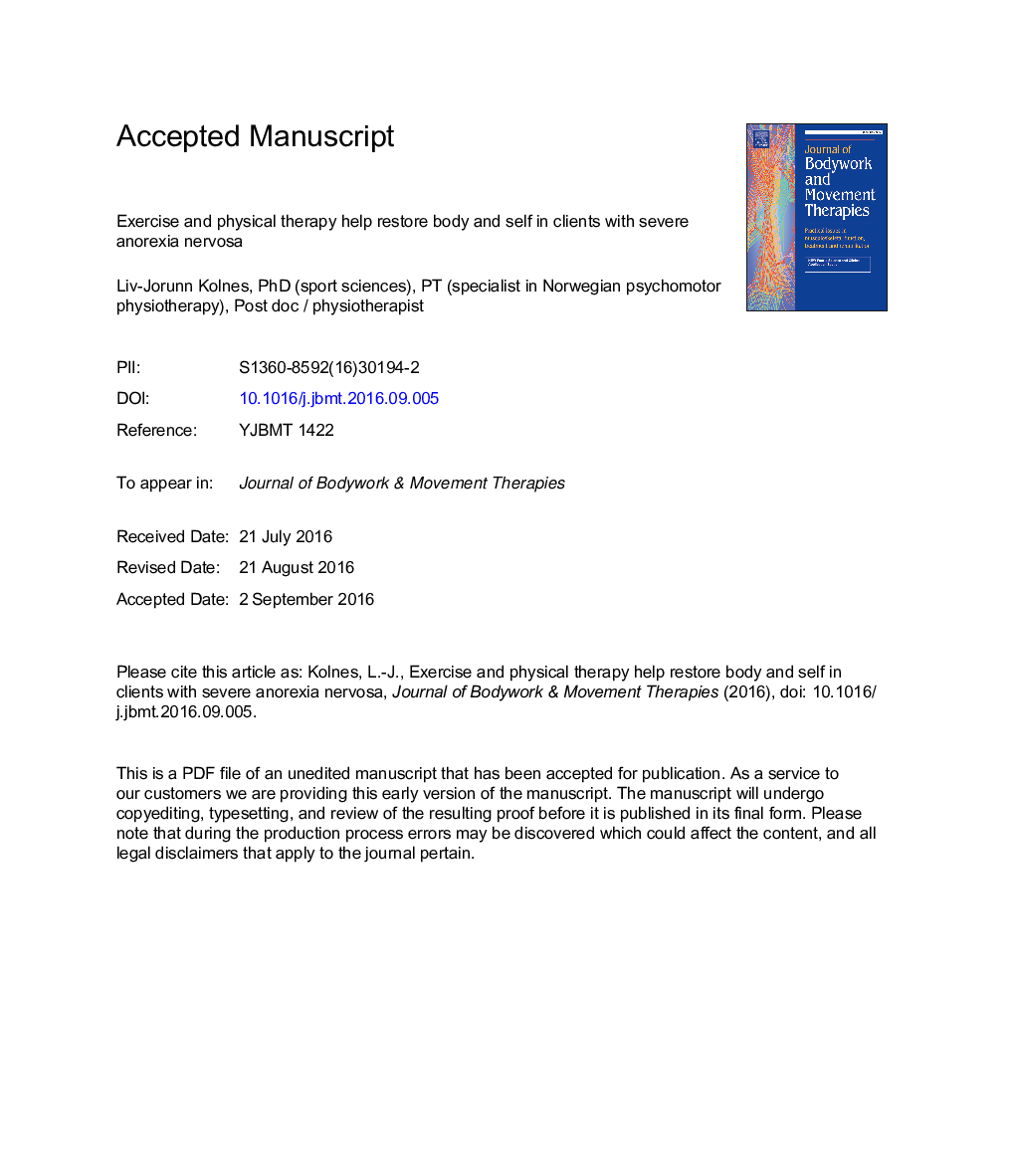| کد مقاله | کد نشریه | سال انتشار | مقاله انگلیسی | نسخه تمام متن |
|---|---|---|---|---|
| 5564004 | 1403495 | 2017 | 37 صفحه PDF | دانلود رایگان |
عنوان انگلیسی مقاله ISI
Exercise and physical therapy help restore body and self in clients with severe anorexia nervosa
ترجمه فارسی عنوان
ورزش و فیزیوتراپی کمک می کند تا بدن و خود را در بیماران مبتلا به ناراحتی شدید عصبی باز کند
دانلود مقاله + سفارش ترجمه
دانلود مقاله ISI انگلیسی
رایگان برای ایرانیان
کلمات کلیدی
بی اشتهایی عصبی، ورزش، فیزیوتراپی، الگوی تنفس، ثبات ظریف بازگرداندن بدن و خود،
ترجمه چکیده
ورزش در زمینه بی اشتهایی عصبی یک تلاش چند بعدی است که توسط اختلاف و عدم اطمینان احاطه شده است. درک گسترده ای از این پدیده ضعیف قابل فهم ضروری است. هدف از این مقاله، با بررسی یافته های یک بررسی جسمانی شش فرد مبتلا به نارسایی اعصاب، و همچنین علم ورزش، پدیده شناسی و عصب شناسی، هدف این مقاله است که در مورد نقش بالقوه ورزش و فیزیوتراپی در درمان آنورکسیا نروا توضیح داده شود. یافته های ارزیابی بدن عبارتند از سفتی وضعیت، ماهیچه ها و الگوی تنفس. این محدودیت های بدنی لزوما فقط با سطح بالایی از ورزش مرتبط نیست، بلکه ممکن است فشار روانی را همراه با بیماری نیز نمایان سازند. به طور خاص تنفس محدود به نظر می رسد که با افکار دشوار و احساسات سرکوب شده همراه باشد. بر اساس نتایج بررسی بدن و همچنین ملاحظات پزشکی و روانشناختی همراه با بیماری، پیشنهاد شده است که مداخلات باید بر بهبود پایداری موضعی و بازسازی عملکرد عضلانی مرتبط تمرکز کنند. یکپارچگی درگیر شدن در این فعالیت ها، پتانسیل ادغام اطلاعات پیشگیرانه در این فرآیند ممکن است یک تجربه ی سازگارتر از بدن، و همچنین خود، در این مشتریان ایجاد کند. بر این اساس، محدودیت های بدن ممکن است نقش مهمی در محدود کردن تجربه ی خود داشته باشند. به عنوان مثال، رسیدگی به محدودیت های بدن در این مشتریان می تواند تجربه سوژه را ایجاد و کنترل حرکات را تسهیل کند. این در مقایسه با تجارب گذشته تمرینات مشتریان است که با اجبار، استحکام و عدم انسجام و کنترل ارتباط دارد.
موضوعات مرتبط
علوم پزشکی و سلامت
پزشکی و دندانپزشکی
طب مکمل و جایگزین
چکیده انگلیسی
Exercise in the context of anorexia nervosa is a multifaceted endeavour surrounded by controversy and uncertainty. A broader comprehension of this poorly understood phenomenon is required. Informed by the findings of a body examination of six individuals with anorexia nervosa, as well as exercise science, phenomenology and neurocognition, the purpose of this article is to elaborate on the potential role of exercise and physical therapy in the treatment of anorexia nervosa. The findings of the body assessment include constriction of posture, muscles and pattern of breathing. These bodily restraints are not necessarily merely associated with high levels of exercise, they may also reflect psychological strain accompanying the illness. The restricted breathing in particular is assumed to be associated with difficult thoughts and suppressed feelings. Based on the results of the body examination, as well as medical and psychological considerations accompanying the illness, it is suggested that interventions should focus on improving postural stability and restoring related muscular function. Integral to engaging in these activities, the potential to integrate proprioceptive information in this process may generate a more coherent experience of the body, as well as of the self, in these clients. Accordingly, constrictions of the body may have a vital role in constraining the experience of the self. As such, addressing bodily restraints in these clients may facilitate the experience of being the subject causing and controlling the movements. This is in marked contrast to clients' previous exercise experiences, which were associated with compulsion, rigidity and the absence of coherence and control.
ناشر
Database: Elsevier - ScienceDirect (ساینس دایرکت)
Journal: Journal of Bodywork and Movement Therapies - Volume 21, Issue 3, July 2017, Pages 481-494
Journal: Journal of Bodywork and Movement Therapies - Volume 21, Issue 3, July 2017, Pages 481-494
نویسندگان
Liv-Jorunn PhD (Sport Sciences), PT (Specialist in Norwegian Psychomotor Physiotherapy),
